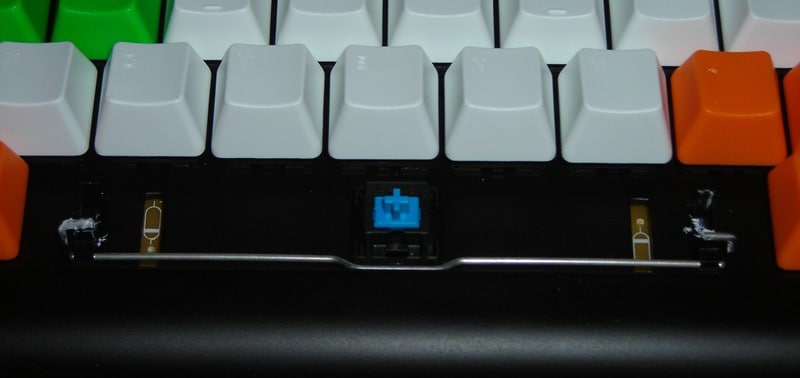We all know what a keyboard is, However, the stabilizer may sound a bit more technical. You may already know about lubing the keyboard switches, or maybe you don’t?
In any case, you may not know that the stabilizer also needs to be lubed. It also uses a different type of lube then the switch.
This post contains affiliate links
Keyboard stabilizing lubes are a form of lubrication for the keyboard system. After using the keyboard for a while, you must have noticed that some buttons become difficult to press. Sometimes the difficulty in pressing is accompanied by squeaky noises.
The texture of the button may even feel a bit different. This is a good pointer for the need for stabilizer lubricants. Before we delve into how to use the lubricant, it would be best to understand some pertinent terms.
In a hurry? My favorite lube to use on stabilizers is this one on Amazon. It’s slightly more expensive then other lubes but it works wonders.
Table of Contents
Keyboard Stabilizers
Keyboard stabilizers are devices found on the keyboard. Stabilizers cannot be identified by merely looking at the keyboard’s interface. The keyboard needs to be disassembled first.

The purpose of the stabilizer, as suggested by its name, is stabilizing large areas of the keyboard. This includes certain keys, such as the spacebar and the enter key.
How Stabilization of the Keyboard Works
In the design of the keyboard, a stabilizer is normally applied. The stabilizer ensures that the motion of the keycap remains vertical all the time. The stabilizer keeps the keycap level regardless of where it is pressed by the user. Stabilization helps in preventing the binding of keycaps.
Stabilizers deter the play inherent in the switch sliders. This play can cause significant tilting or wobbling of the larger keys. Particularly susceptible to this effect are the space and enter buttons on the keyboard.
Normally, stabilizers should be used on the larger keys. Larger keys are the ones with equal or more than 1.75 units width. The unit describes the button’s width based on the size of a normal key letter. Stabilization is not limited to large keys only. Smaller keys can also be stabilized.
Design of Stabilizers
Various methods of designing stabilizers exist. Some common ones are described below.
- The wire design: The design involves running a stiff wire from one end of the key to the other. The stiff wire is connected to the keycap’s ends and the keyboard’s plate using a form of restraint. This design ensures the keycaps remain vertical and level at all times.
- Dummy switch design: In this design, a normal switch is paired with a dummy switch. The dummy switch helps with the stabilization.
- Guide shaft design: The process involves the use of plastic inserters and guided shafts. The inserter which bears a guiding shaft is fitted in the keycap’s plastic post to provide stabilization. This method is regarded as poor quality of stabilizing keyboards.
Keyboard Stabilizer Lube
Stabilizer lubes are lubricants that are used to improve the performance of the stabilizers. Sometimes you may notice that the keyboard buttons are pretty difficult to press. If you manage to press them, they produce a squeaky sound. Such an irritating experience!
In such scenarios, the first thing to check would be the stabilizers. The discomfort may be a result of damaged stabilizers on the keyboard. If indeed it is confirmed that the stabilizer not bent or broken, then there would be a need to lubricate them.
Stabilizer lubricant reduces the friction on the stabilized keyboard. The reduction in friction will ease the vertical motion of the keycap. The lubricant should also reduce the noise when typing.
A variety of stabilizers are available on Amazon. The choice of a stabilizer to use is subjective. The general rule for choosing stabilizers is to go for plastic compatible ones. Lubricants that contain petroleum distillates will damage the keyboard.
Kinds of Stabilizer Lubes to Use
As mentioned earlier, not every lubricant available in hardware shops is appropriate. Some may contain elements that might damage the device.
Petroleum-based lubricants should be avoided at all costs. Petroleum distillates dissolve any styrene compound. Plastics, which are used in keyboard making, is rich in styrene compounds.
Having avoided petroleum-based lubricants, the following lubricants can be considered.
- Light silicone grease lubricants: These lubricants are excellent performers at high temperatures. They have both thermal and electrical insulating capabilities. Silicone lubricants are not known to react detrimentally with plastic. Silicone greases can withstand demanding loads too.
- Lithium grease lubricants: Lithium lubricants great lubrication for a longer period. Their viscosity formula is high. This means they would not drip if used on keyboard stabilization. Also, the lubricant works quite effectively under heavy loads.
- Teflon lubricants: Officially known as polytetrafluoroethylene. This is a form of a polymer-based lubricant. When used in its dried form, the Teflon works very well as a stabilizing lube. Teflon lubricant reduces the frictional resistance between surfaces. The lubricant is inert with other chemicals hence lower chances of reacting with the plastic. Additionally, Teflon lubricants make the surfaces coated to be wet resistant.
- Powdered graphite lubricants: Just as the Teflon, this is a form of a dry lubricant. Graphite has an excellent chemical resistance which makes the lubricant unreactive with plastics. The high creep resistance of graphite enables it to sustain loads without being damaged. Lastly, the low friction of graphite lubricants would help with the keyboard noises.
How to Use Stabilizer Lubricants
Knowing the kind of lubricant you are using is one thing. Knowing how to use the lubricant is another. In this section, I will go over exactly how to apply the lube to your stabilizer.
Below are some tips on stabilizer use.
- Identify the region where the stabilizer is located: Not all the parts of the keyboard require the use of a stabilizer. Sometimes it is just one key that needs the lubricant. Knowing the area to apply the lubricant is important. It will reduce the time for disassembling the keyboard. Most common places are the space and enter keys.
- Remove the keycaps on the region of interest: After identifying the region of interest, disassembling the keycaps should follow. Keycaps are easy to remove. Sometimes just pulling them off would work. The assistance of a professional should, however, be sought. Care should be taken while removing keycaps especially the new ones. Sometimes stabilizers are fitted tightly on the keycaps. Using excessive force on such caps can cause their breakage.
- Remove the switches: Removing the keycaps will allow you to access the switches. Switches can be removed through pulling. A switch removal tool is recommended for this exercise. Use the switch remover to grab the switches of interest. Gently lift the switches after grabbing. They should come off. Be careful not to dig deeper with the switch removal tool. Otherwise the risk of scratching the plate increases.
- Remove the stabs: Stabs have small clips at the top. Once the switches are removed, the stabs can be pulled out using the fingernails. When using the fingernails, make sure to lift the housing towards your direction. The motion of lifting the housing should be similar to that of pulling the stabs. This ensures the stabs are unclipped from their plate. Once the stabs are off, the entire stabilizer assembly can be removed.
- Lubricate the stabs: After removing the stabs, the lubrication process should commence. Stabs are lubricated in two key areas. The joint area where the bar rests in and on the insides.
To remove the bar from the joint area, pull it off gently. The bars are in tension so this should be easy. Apply a small amount of the lube on a toothpick and apply it to the joint area.
To apply the lube on the insides of the stab, the stabilizer will have to be removed completely. After the removal, the lubricant can then be applied in minimal quantities. The application is done on the sides of the housing and the center of the stab.
Removing the stabilizer can be quite challenging. An alternative is to use tweezers. The tweezers should help in getting hold of the stab’s stem to pull it. Use a toothpick with a bit of the lube to apply to the area left by the stab’s stem.
This is the entire process of lube application. Reassembling of the keyboard can be done after completing the process. The process should help in reducing the noise from the keypads if done correctly.
Improve your Keyboard Experience
Applying lubricants on the keyboard’s stabilizers reduces the noise produced while typing. It reaches a point in a keyboard life where this noise production is inevitable. The lubricant should at least reduce this to a manageable level.
Another cause for alarm would be keypads that are difficult to press. This is because of the friction generated by the moving key switch. Lubricants can reduce this friction. They improve the typing experience.
Conclusion
Keyboards are essential tools when it comes to interacting with your computer. Keeping it well maintained should be your number one priority.
Using keyboard stabilizer lube is one way to keep your keyboard functioning like brand new. You may already lube the key switches, but don’t neglect the stabilizers.

